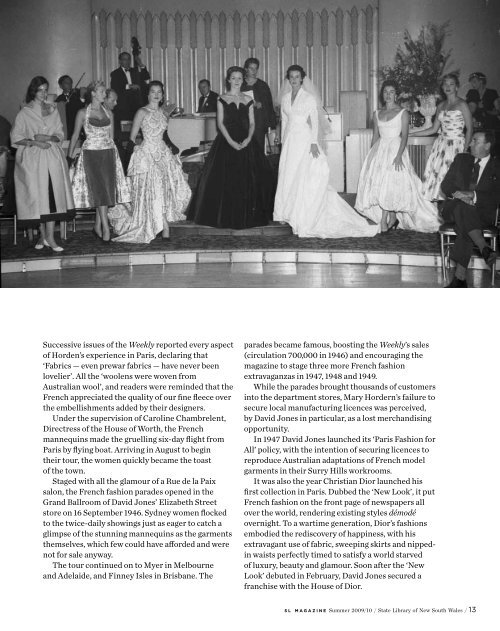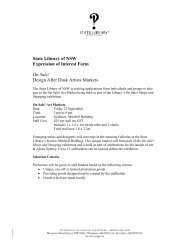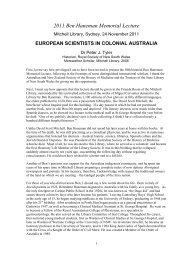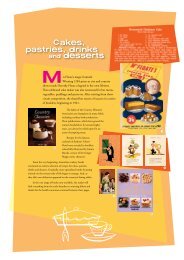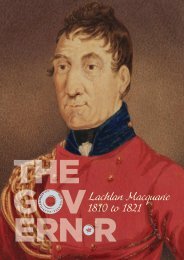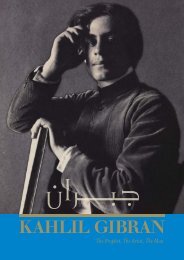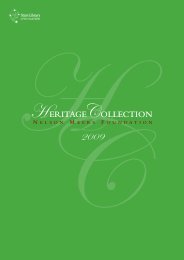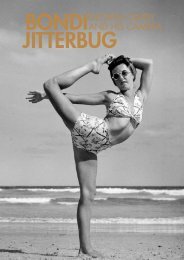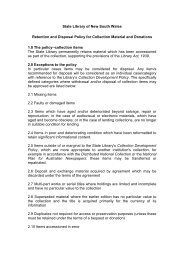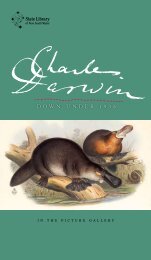Countdown to Mitchell centenary - State Library of New South Wales
Countdown to Mitchell centenary - State Library of New South Wales
Countdown to Mitchell centenary - State Library of New South Wales
You also want an ePaper? Increase the reach of your titles
YUMPU automatically turns print PDFs into web optimized ePapers that Google loves.
Successive issues <strong>of</strong> the Weekly reported every aspect<br />
<strong>of</strong> Horden’s experience in Paris, declaring that<br />
‘Fabrics — even prewar fabrics — have never been<br />
lovelier’. All the ‘woolens were woven from<br />
Australian wool’, and readers were reminded that the<br />
French appreciated the quality <strong>of</strong> our fine fleece over<br />
the embellishments added by their designers.<br />
Under the supervision <strong>of</strong> Caroline Chambrelent,<br />
Directress <strong>of</strong> the House <strong>of</strong> Worth, the French<br />
mannequins made the gruelling six-day flight from<br />
Paris by flying boat. Arriving in August <strong>to</strong> begin<br />
their <strong>to</strong>ur, the women quickly became the <strong>to</strong>ast<br />
<strong>of</strong> the <strong>to</strong>wn.<br />
Staged with all the glamour <strong>of</strong> a Rue de la Paix<br />
salon, the French fashion parades opened in the<br />
Grand Ballroom <strong>of</strong> David Jones’ Elizabeth Street<br />
s<strong>to</strong>re on 16 September 1946. Sydney women flocked<br />
<strong>to</strong> the twice-daily showings just as eager <strong>to</strong> catch a<br />
glimpse <strong>of</strong> the stunning mannequins as the garments<br />
themselves, which few could have afforded and were<br />
not for sale anyway.<br />
The <strong>to</strong>ur continued on <strong>to</strong> Myer in Melbourne<br />
and Adelaide, and Finney Isles in Brisbane. The<br />
parades became famous, boosting the Weekly’s sales<br />
(circulation 700,000 in 1946) and encouraging the<br />
magazine <strong>to</strong> stage three more French fashion<br />
extravaganzas in 1947, 1948 and 1949.<br />
While the parades brought thousands <strong>of</strong> cus<strong>to</strong>mers<br />
in<strong>to</strong> the department s<strong>to</strong>res, Mary Hordern’s failure <strong>to</strong><br />
secure local manufacturing licences was perceived,<br />
by David Jones in particular, as a lost merchandising<br />
opportunity.<br />
In 1947 David Jones launched its ‘Paris Fashion for<br />
All’ policy, with the intention <strong>of</strong> securing licences <strong>to</strong><br />
reproduce Australian adaptations <strong>of</strong> French model<br />
garments in their Surry Hills workrooms.<br />
It was also the year Christian Dior launched his<br />
first collection in Paris. Dubbed the ‘<strong>New</strong> Look’, it put<br />
French fashion on the front page <strong>of</strong> newspapers all<br />
over the world, rendering existing styles démodé<br />
overnight. To a wartime generation, Dior’s fashions<br />
embodied the rediscovery <strong>of</strong> happiness, with his<br />
extravagant use <strong>of</strong> fabric, sweeping skirts and nippedin<br />
waists perfectly timed <strong>to</strong> satisfy a world starved<br />
<strong>of</strong> luxury, beauty and glamour. Soon after the ‘<strong>New</strong><br />
Look’ debuted in February, David Jones secured a<br />
franchise with the House <strong>of</strong> Dior.<br />
s l m a g a z i n e Summer 2009/10 / <strong>State</strong> <strong>Library</strong> <strong>of</strong> <strong>New</strong> <strong>South</strong> <strong>Wales</strong> / 13


